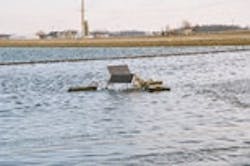Mixers Cut Costs, Odors in Ohio Wastewater Treatment Plant
In the Buckeye State, the village of St. Henry, Ohio, is bucking the trend of many rural farming communities. Instead of losing residents and local businesses to bigger cities, this community 40 miles northwest of Dayton is growing. Local industries such as turkey processing are expanding as well. Consequently, the city of 2,700 was outgrowing the capacity of its wastewater treatment plant.
But St. Henry is still a small town with a limited tax base, so when city officials learned that new wastewater treatment equipment would cost almost half a million dollars and add $49,000 in annual energy costs, they looked elsewhere for a solution. Not only did they find an answer, they also saved on their utility bill.
Instead of adding energy-consuming aeration equipment, they saved $100,000 in capital equipment costs by adding solar-powered mixing equipment to the existing plant. Mixing equipment from Medora Corp., Dickinson, N.D., thoroughly mixes the ponds and significantly reduces energy consumption.
“The problem with the old system was that it was undersized,” said Stan Sutter, public utilities supervisor for St. Henry. “We needed more aeration and we needed a new cell for extra storage capacity. Originally, we considered installing a diffuser blower system that would replace the surface aerators.” Three big blowers would blow air through a common header along the whole outside of the lagoon. “But the blower system would have increased our horsepower by 30% and our utility bill as well. We were determined to solve our problems without all that extra expense.”
The treatment plant not only had to meet the needs of the growing population and expanding industry, it also had to smell better. The solution that St. Henry staff and consulting engineers developed was to reconfigure the first pond, reduce mechanical aeration run time and add solar-powered mixing to thoroughly mix the ponds and reduce odors.
Solar-Powered Mixing Technology
The technology from Medora Corp. combines solar power with long-distance, near-laminar-flow circulation to provide radial, horizontal and vertical pond mixing. SolarBee mixers operate day and night to circulate and mix wastewater ponds of all types. They help to conserve dissolved oxygen by distributing saturated surface water throughout the pond, replacing 20 to 40 hp of aeration run time per mixer.
As a result of this mixing efficiency, St. Henry officials can offload a significant portion of their energy-intensive aeration run time, while significantly reducing biochemical oxygen demand (BOD), total suspended solids (TSS) and ammonia. Near-laminar-flow circulation also solved the odor problem and reduced sludge buildup.
Medora Corporation’s mixing equipment is designed around pumps capable of moving up to 10,000 gal per minute, or 14.4 million gal per day (mgd). Because of the unique hydraulic design, the system uses only a few watts to power a 0.5-horsepower direct-drive motor that is 90% or more efficient. Three 80-watt photovoltaic panels charge an onboard battery, thus enabling the units to run day and night on solar power.
Deodorizing & Saving
Reconfiguring St. Henry’s wastewater treatment plant meant dividing the first pond into two sections. The purpose of dividing the eight-acre, rectangular-shaped pond was to concentrate the treatment in a small, total-mix, high-solids lagoon and essentially create an activated-sludge basin without the expense of building one. In section A of the first pond, eight aerators and one SolarBee mixer concentrate the aeration and provide deeper mixing. Approximately 800 to 1000 mg/L of carbon biochemical oxygen demand (CBOD) run through the first cell and about 100 mg/L of CBOD leave the pond after a three-day detention time.
After the first pond, the system returns to a facultative system. During the day, the gentle and continuous mixing of the SolarBee mixers brings nutrients to the surface of the pond to promote an increased and highly beneficial algae growth. The algae produce energy-free pure dissolved oxygen—up to 250 lbs. of dissolved oxygen per acre per day. A high pH also occurs near the surface. The high dissolved oxygen and high-pH water is continuously and thoroughly mixed throughout the pond, instead of being mostly underutilized, as in all-natural ponds. The higher dissolved oxygen throughout the pond helps reduce BOD by 70% to 90%. And, most noticeable to St. Henry residents is the fact that the bad odors have been virtually eliminated.
In total, seven SolarBee mixers and 11 aerators mix and aerate the lagoons to meet permit requirements. A new fourth pond was also installed, which provides an additional 67 million gal of storage. By the time wastewater reaches the fourth pond, there is not enough carbon, ammonia or phosphorous to cause permit problems, or to support algae growth high enough to result in BOD and TSS problems. Better yet for the St. Henry municipal budget, aeration run-time has been cut by 60% and the utility bill by $20,000 per year.
To Stan Sutter, that’s a “green” payback. “Green goes hand in hand with operational cost savings,” he said. “We’re not consuming nearly as much power as we were originally looking at. In fact, we’ve decreased our horsepower rather than increasing it, and any time we can use fewer resources, it benefits the entire community.”
With a renewed wastewater treatment system designed with an eye on saving big bucks, St. Henry is well prepared for future population growth and new industries and to meet stringent regulatory requirements.
Michael Christensen is east U.S. manager, Medora Corp. Christensen can be reached at 970.484.3437.
